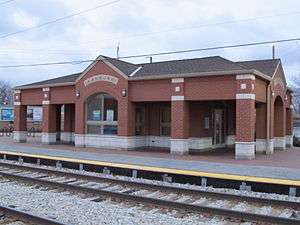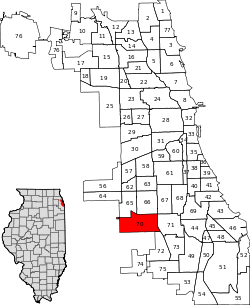Ashburn, Chicago
Ashburn, one of Chicago's 77 community areas, is located on the south side of the city. Greater Ashburn covers nearly five square miles. The approximate boundaries of Ashburn are 72nd Street (north), Western Avenue (east), 87th Street (south) and Cicero Avenue (west).[2]
Ashburn | |
|---|---|
Community area | |
| Community Area 70 - Ashburn | |
 Ashburn station at 83rd Street and Central Park Avenue. | |
 Location within the city of Chicago | |
| Coordinates: 41°45.0′N 87°42.6′W | |
| Country | United States |
| State | Illinois |
| County | Cook |
| City | Chicago |
| Neighborhoods | list
|
| Area | |
| • Total | 4.87 sq mi (12.61 km2) |
| Population (2015[1]) | |
| • Total | 42,752 |
| • Density | 8,800/sq mi (3,400/km2) |
| Demographics 2015[1] | |
| • White | 13.00% |
| • Black | 48.29% |
| • Hispanic | 36.15% |
| • Asian | 0.72% |
| • Other | 0.19% |
| Time zone | UTC-6 (CST) |
| • Summer (DST) | UTC-5 (CDT) |
| ZIP Codes | 60652 |
| Median income[1] | $63,573 |
| Source: U.S. Census, Record Information Services | |
History
Ashburn, which got its name as the dumping site for the city's ashes, was slow to experience growth at the beginning of the 20th century. In 1893, the "Clarkdale" subdivision was planned near 83rd and Central Park Avenue along the new Chicago and Grand Trunk Railway, with only 19 homes built in the first 50 years. The early residents were Dutch, Swedish and Irish. Ashburn opened Ashburn Flying Field, the first airfield in Chicago, in 1916, becoming the home to the E. M. Laird Airplane Company. The marshy airfield closed in 1939.[3] The post-World War II economic boom, the industrial boom of Ford City, and the baby boom all contributed to population growth in the 1950s and 1960s. Affordable home prices and proximity to the Chicago Loop helped the boom.[4] Before Bogan High School was built, and before the area west of Pulaski Road was developed, ash 'heaps' were visible in the area south of Ford City but north of 79th Street.
Along the southern edge of Ashburn, the square mile to the west is known as Scottsdale (due to the developer naming the area after his son, Scott) or St. Bede Parish. The center square mile is known as Ashburn or St. Denis Parish (which includes the now-defunct St. Denis Grammar School), and the easternmost square mile is known as Wrightwood, St. Thomas More Parish. The population of Greater Ashburn was predominantly Irish-Catholic until the 1990s when the area began to diversify with the migration of the African Americans moving in and the whites moving out. The economic landscape of the community began to suffer when the whites relocated, taking establishments that they often owned, out of the community. In the 1950s, St. Denis Grammar School was home to over 2,000 children, many of whom were in classrooms of 40+ students each. Classes during the 1959 White Sox 1959 World Series were held in the basement of the school due to overcrowding. There were also two shifts of school grades for grade 4. The pastors at St. Denis (Father Doyle, Father Hanley and Father Fullmer) were devoted to expanding the facilities and serving the Catholics, but could never have enough classrooms to house all the Catholic children in the classrooms in the mid to late 1950s. There was a satellite school at Springfield Avenue & 82nd Place in the early 1950s, and Dawes Elementary was filled, so much so that new schools, Carroll and Hancock, were built shortly after Dawes Elementary.
In 1999, The New York Times did an article on the Ashburn neighborhood as a case study in the difficulties of neighborhood integration in Chicago. Wrightwood, to the east, was the first section of the neighborhood to integrate, becoming dominantly African-American. Ashburn experienced a significant transition to a racially blended middle-class population of firefighters, policemen and policewomen, teachers, and other city workers. Scottsdale, to the west, has remained predominately white.
A WBEZ report [5] conducted in July 2017 regarding Ashburn's continued segregation issues of becoming more segregated in time indicated, "Ashburn has seen a lot of racial change since 1990 and appears to be integrated - at least on paper." It further states that Ashburn is the only neighborhood in Chicago with a dominant middle class black population, to add black residents from 2000 - 2010, at a time when black people have been leaving the city in droves.
Neighborhoods
Beverly View
Beverly view is located in the far eastern section of Ashburn. The population was 996 and the racial makeup was 82.4% African American, 14.3% White, 1.1% Hispanic or Latino, 1.1% Asian, and 1.1% of Mixed Race.[6] Beverly View is bounded by West 79th Street to the north, 81st Street to the south and east, and Western Avenue to the west.
Wrightwood
Wrightwood is located in the eastern section of Ashburn in Chicago. The most recent population for Wrightwood was 9,540 and the racial makeup for the neighborhood was 87.7% African American, 4.6% Hispanic or Latino, 4.1% of Mixed Race, and 3.6% White.[7] Wrightwood is bounded by West Columbus Avenue to the north, 87th Street to the south, Western Avenue to the west, and Kedzie Avenue to the East.
Marycrest
Marycrest is located in the east central portion of Ashburn in Chicago. The most recent population for Marycrest was 541 and the racial makeup was 80.6% African American, 16.4% Hispanic or Latino, and 3.0% White.[8] Marycrest is bounded by West 85th Street to the north, 87th Street to the south, Kedzie Avenue to the east, and Central Park Avenue to the West.
Parkview
Parkview is located in the central portion of Ashburn in Chicago. The most recent population for Parkview was 1,463 and the racial makeup was 54.1 African American, 31% Hispanic or Latino, 14.2% White, and 0.7% Asian.[9] Parkview is bounded by West Columbus Ave to the northwest, Central Park Avenue to the east, Pulaski Avenue to the west, 87th Street to the south.
Scottsdale
Scottsdale is located in the far western portion of Ashburn in Chicago. The most recent population for Scottsdale was 14,207 and the racial makeup was 62.7 Hispanic or Latino, 22.7% White, 12.7% African American, 1.2% Asian, and 0.5% of Mixed Race.[10] Scottsdale is bounded by Cicero Avenue to the west, Pulaski Avenue to the east, 77th Street to the north, and 87th Street to the south.
GADA and NEXTdoor
In 2016, the Greater Ashburn Development Association (GADA) was created to replace the now defunct Greater Ashburn Planning Association (GAPA). They were created to bring the entire Ashburn community back together through concerted efforts of multi-organizational support. Its mission: to foster strategic relationships between the businesses and residents to create economic prosperity while partnering with surrounding communities and organizations to strengthen the forces against the challenges of potential blight, while continuing to seek a resolution to the mechanisms of gradual succession.
As a result of the formulation of GADA, Ashburn had its first Summer Extravaganza, turning out over 500 community residents, business owners, sponsors and supporters. In 2017, because of the efforts of GADA and the Ashburn community's online neighborhood platform (NEXTdoor/Ashburn), they were the only predominantly African American community in Chicago to receive the Good Neighbor Award from the NEXTdoor organization, a nonprofit company whose mission is to support neighborhoods in becoming stronger advocates for themselves. Jen Burke, NEXTdoor staff writer, writes, "Every day, we come across incredible stories of how neighbors are using Nextdoor to improve each other’s lives and their larger community - one neighborhood on the South Side of Chicago, Ashburn, has done just that – in a big way".[11]
The Ashburn NEXTdoor founder, Shaun R. "Pink" Pinkston, an Ashburn resident of 16 years, created the platform in 2013 in an effort to bring the community together. As of April 12, 2019, the platform has nearly 3,000 resident members and business owners who share community news, safety awareness concerns and get to know one another.
Transportation
METRA's SouthWest Service provides Monday–Saturday rail service at the Ashburn and Wrightwood railroad stations.
| Historical population | |||
|---|---|---|---|
| Census | Pop. | %± | |
| 1930 | 733 | — | |
| 1940 | 731 | −0.3% | |
| 1950 | 7,472 | 922.2% | |
| 1960 | 38,638 | 417.1% | |
| 1970 | 47,153 | 22.0% | |
| 1980 | 40,477 | −14.2% | |
| 1990 | 37,092 | −8.4% | |
| 2000 | 39,584 | 6.7% | |
| 2010 | 41,081 | 3.8% | |
| Est. 2015 | 42,752 | 4.1% | |
| [1][12] | |||
Politics
Ashburn has strongly supported the Democratic Party in the past two presidential elections. In the 2016 presidential election, Ashburn cast 14,929 votes for Hillary Clinton and cast 1,690 votes for Donald Trump.[13] In the 2012 presidential election, Ashburn Park cast 15,436 votes for Barack Obama and cast 1,718 votes for Mitt Romney.[14]
Ashburn's first female African American Alderperson, Lona Lane, who presided over the community for over 20 years, was replaced by the community's former Streets and Sans Superintendent, Derrick G. Curtis, now in his second term.
Notable residents
Notable residents (current or former) include:
- Ed Farmer, radio sports announcer and former MLB player
- Tim McCarthy, retired member of the United States Secret Service. He took a bullet for President Ronald Reagan during an assassination attempt by John Hinckley Jr..[15]
- Tom Tunney, member of the Chicago City Council from the 44th ward on the north side of Chicago. He was raised in Ashburn.[16][17]
- Jim Zulevic, actor and comedian
Schools
The Ashburn area serves as a home to many schools such as Ashburn Community Elementary School, Carroll Elementary School, Dawes Elementary School, Durkin Park Elementary School, Stevenson Elementary School, Lionel Hampton Fine & Performing Arts School, Owens Scholastic Academy, Ashburn Lutheran School, St. Bede the Venerable Catholic School, Sarah E. Goode STEM Academy, St. Rita of Cascia High School, and William J. Bogan High School.[18]
References
- "Community Data Snapshot" (PDF). cmap.illinois.gov. MetroPulse. Retrieved November 23, 2017.
- "Official City of Chicago Ashburn Community map" (PDF). cityofchicago.org. Retrieved April 14, 2019.
- "Ashburn". Retrieved November 16, 2011.
- "Ashburn Chicago Real Estate, Homes for Sale - Falcon Living". falconliving.com. Retrieved April 14, 2019.
- Emmanuel, Adeshina; Cruz, Carolina; Unrau, Reuben. "Is Notoriously Segregated Chicago Becoming Integrated?". WBEZ. Retrieved April 14, 2019.
- https://statisticalatlas.com/neighborhood/Illinois/Chicago/Beverly-View/Race-and-Ethnicity
- https://statisticalatlas.com/neighborhood/Illinois/Chicago/Wrightwood/Race-and-Ethnicity
- https://statisticalatlas.com/neighborhood/Illinois/Chicago/Marycrest/Race-and-Ethnicity
- https://statisticalatlas.com/neighborhood/Illinois/Chicago/Parkview/Race-and-Ethnicity
- https://statisticalatlas.com/neighborhood/Illinois/Chicago/Scottsdale/Race-and-Ethnicity
- Burke, Jen (July 13, 2017). "Chicago's Ashburn Neighborhood Hosts Community Celebration". nextdoor.com. Retrieved April 14, 2019.
- Paral, Rob. "Chicago Community Areas Historical Data". Archived from the original on March 18, 2013. Retrieved September 3, 2012.
- Ali, Tanveer (November 9, 2016). "How Every Chicago Neighborhood Voted In The 2016 Presidential Election". DNAInfo. Archived from the original on September 24, 2019. Retrieved October 4, 2019.
- Ali, Tanveer (November 9, 2012). "How Every Chicago Neighborhood Voted In The 2012 Presidential Election". DNAInfo. Archived from the original on February 3, 2019. Retrieved October 4, 2019.
- Connolly, Dermot (July 14, 2016). "Chief McCarthy named interim village manager". The Regional News. Retrieved November 13, 2016.
- Gorman, John (June 11, 1975). "Home owners berate builder". Chicago Tribune – via ProQuest.
- Finley, Larry (September 25, 2007). "Builder, alderman's dad: Last member of family business, real estate broker". Chicago Sun-Times. Retrieved October 31, 2019.
- "Bogan Computer Technical High School". archive.is. January 12, 2013. Archived from the original on January 12, 2013. Retrieved April 14, 2019.